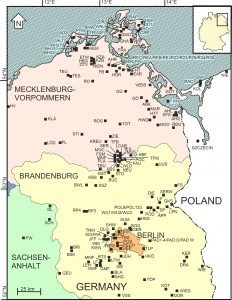Patterns in vegetation and sedimentation during the Weichselian Lateglacial in NE Germany
A comparison of available pollen diagrams from NE Germany covering (part of) the Weichselian Lateglacial shows that some conspicuous differences exist in pollen values and in sediment/sedentates for the various vegetation phases between the regions of N Vorpommern and S Mecklenburg / N Brandenburg / Berlin.
First of all, the pollen diagrams from the southern part of NE Germany show hardly any sign of Open vegetation phase II (“Older Dryas”), which separates the Hippophaë phase (“Bølling”) from the Lateglacial Betula/Pinus forest phase (“Allerød”) (for the “vegetation phases of Vorpommern” see the research of the Endinger Bruch area). This might be due to the fact that the warmth-demanding Hippophaë did not disappear from the vegetation in the southern regions as consequence of slightly higher summer temperatures, or to the fact that in general vegetation remained denser in Open vegetation phase II (thus preventing an increase of soil erosion and consequent enlarged sediment accumulation due to which this very short phase is often missed during sampling).
 Palynologically analysed sites in NE Germany covering (part of) the Weichselian Lateglacial
Palynologically analysed sites in NE Germany covering (part of) the Weichselian Lateglacial
Secondly, pollen attributable to pine reaches much higher values in the Lateglacial Betula/Pinus forest phase (“Allerød”) in the southern regions than in northern Vorpommern, and at lower palynostratigraphic levels, thus dividing the Lateglacial Betula/Pinus forest phase into two subphases, whereas in northern Vorpommern four subphases are distinguishable. This might be due to a climate-induced delayed immigration of pine in the northern regions, but might also be the consequence of edaphic differences between the predominantly till-plain landscape in the northern region and the predominantly sandy outwash-plains in the south (cf. Theuerkauf 2003).
A third difference is that in northern Vorpommern the sediments from Open vegetation phase III (“Late Dryas” / “Younger Dryas”) are thicker than the sediments of the Late Weichselian forest phase and are mainly clastic. At the southern localities, in general, the deposits from Open vegetation phase III are thinner than those of the Lateglacial Betula/Pinus forest phase (“Allerød”) and of organic character. This is attributed to the fact that during Open vegetation phase III – at least along the basin slopes – the vegetation was much opener in northern Vorpommern, favouring larger upland erosion and subsequent deposition of clastic material. In the southern regions, on the contrary, primary production prevailed as the dominant source for sediments, which was reduced as consequence of the lower temperatures: this resulted in lower accumulation rates and thinner total sediments. The denser vegetation in the southern regions related probably to higher temperatures during Open vegetation phase III compared to the northern regions.
Publication:
De Klerk, P. (2008): Patterns in vegetation and sedimentation during the Weichselian Late-glacial in north-eastern Germany. Journal of Biogeograpy 35: 1308-1322. doi: 10.1111/j.1365-2699.2007.01866.x
De Klerk, P. & Stolze, S. (2002): Unterschiede in Vegetation und Sedimentation zwischsen N-Vorpommern und S-Mecklenburg: Ein spätglazialer Klimagradient? Greifswalder Geographische Arbeiten 26: 161-165.
Related publications:
Brande, A. (1995): Younger Dryas vegetation gradient in northeast Germany. Terra Nostra Schriften der Alfred-Wegener-Stiftung 2/95: 35.
De Klerk, P. (2002): Changing vegetation patterns in the Endinger Bruch area (Vorpommern, NE Germany) during the Weichselian Lateglacial and Early Holocene. Review of Palaeobotany and Palynology 119: 275-309.
De Klerk, P. (2004): Confusing concepts in Lateglacial stratigraphy and geochronology: origin, consequences, conlusions (with special emphasis on the type locality Bøllingsø). Review of Palaeobotany and Palynology 129: 265-298.
Terberger, T., de Klerk, P., Helbig, H., Kaiser, K. & Kühn, P. (2004): Late Weichselian landscape development and human settlement in Mecklenburg-Vorpommern (NE Germany). Eiszeitalter und Gegenwart 54: 138-175.
Theuerkauf, M. (2003): Die Vegetation NO-Deutschlands vor und nach dem Ausbruch des Laacher See-Vulkans (12880 cal. BP). Greifswalder Geographische Arbeiten 29: 143-189.
Your e-mail address will not be published.